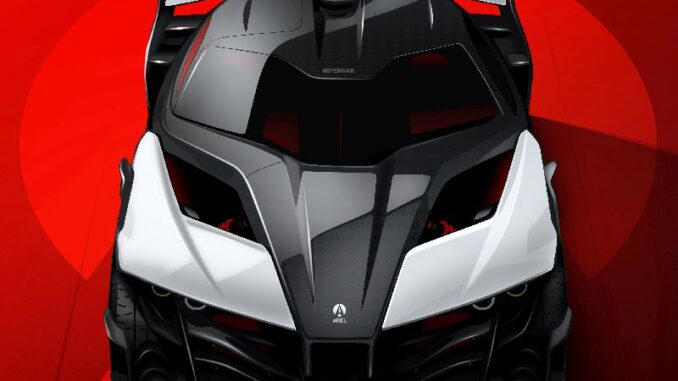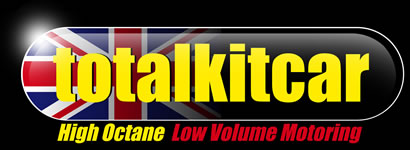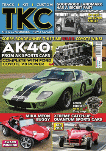
Ariel Motor Company, manufacturers of the Atom and Nomad cars and Ace motorcycle, has released details of their all-new, ultra-high performance, range extended, electric sportscar project – HIPERCAR.
Standing for High Performance Carbon Reduction, the project is destined for full release in 2019 and Ariel production in 2020 alongside the Atom, Nomad and Ace. As with other Ariel vehicles the focus of HIPERCAR is on extreme performance, agility and usability, now coupled with zero and ultra-low emissions. To be available in four-wheel drive and two-wheel drive variants, HIPERCAR will offer staggering performance utilising cutting edge, UK developed technology and will be built in Somerset, England by Ariel.
Phase one of the project, undertaken by Ariel with partners Equipmake and Delta Motorsport, will demonstrate both two-wheel drive and four-wheel drive prototypes and will be shown at the Low Carbon Vehicle (LCV) Show at Millbrook on September 6 & 7, 2017.
To be initially unveiled as a rolling chassis with all componentry visible, Simon Saunders, Director of Ariel, said, ‘We’re not unveiling final bodywork at this stage and it’s unusual for a car manufacturer to do things this way round. What you usually get is an exterior concept with some vague promises about what is happening underneath and how wonderful it’s going to be. But, as ever, we’re different at Ariel and the core of HIPERCAR is the technology, the design and the engineering so that’s what we are showing. This is an important part of Ariel’s future so it has to be right.”
HIPERCAR, with a model name yet to be decided, is not just an Ariel production car, destined to be one of the highest performance and sought after vehicles in the world, but also a launchpad of UK developed technology into other niche, medium volume and ultimately high volume production. The vehicle showcases what the UK can achieve in the highly competitive and fast changing automotive sector with all key HIPERCAR components – motor, gearbox, battery, power electronics, range extender, chassis, driveline and mechanical components – developed by British companies. “Developing another of the fastest cars in the world is important for Ariel,” said Saunders, “but anchoring the technology in this country and building a British supply chain is vital for the economy.”
HIPERCAR began as a feasibility study in 2014 to investigate the direction for future Ariel growth and additional production cars to built alongside the Atom and Nomad. The study, drawing on Ariel’s background, combined their drive to produce world-beating performance cars with UK government policy to reduce automotive emissions. Investigating various hybrid architectures and analysing readiness of new automotive technologies, the study carried out exhaustive simulations to establish performance targets and overall requirements for the vehicle. It proved that not only was a range extended EV (Electric Vehicle) viable but that it had the ability to substantially outperform the equivalent pure internal combustion engine and mild hybrid cars in the Supercar sector, while maintaining zero and ultra-low emissions.
From this initial study HIPERCAR grew into a major R&D project, with Ariel being joined by partners Equipmake of Hethel and Delta Motorsport of Silverstone, winning over £2m in R&D funding from Innovate UK, the UK’s innovation agency, to help develop the various technologies. Motors, power electronics, batteries, range extender and chassis have all been developed within HIPERCAR.
Two battery packs have been developed for the car, one within the HIPERCAR project for the four-wheel drive car and another within a separate £12m Innovate UK funded battery research project (AMPLiFII) for the two-wheel drive version. The Ariel HIPERCAR platform takes the output of a number of UK R&D projects and turns them into production reality, beginning to build a UK automotive supply chain of the future.
Jon Beasley, Director – Technology and Projects at the Advanced Propulsion Centre, said: “The HIPERCAR Project is a great example of how smaller companies and members of the UK’s Niche Vehicle Network are creating opportunities to adopt, and bring to market, cutting edge low-carbon technology through their future vehicle programmes. This is one of a number of projects in the Advanced Propulsion Centre’s portfolio that is significantly reducing CO2 and safeguarding or creating jobs, in addition to developing UK automotive capability. APC8, the next round of funding is now open.”
Powered wheels are driven by inboard motors via integral, single speed step-down gearboxes direct to driven wheels, with each individual motor developing 220kW (295bhp) and 450Nm (332 ft lb) of torque
In four-wheel drive total power is therefore 880 kW (1180bhp) and in two-wheel drive form 440kW (590bhp).
Total torque is 1800 Nm (1327 ft lb) at motor and 9900 Nm (7301 ft lb) at the wheels in the four-wheel drive HIPERCAR and 900Nm (664 ft lb) at motor and 4950 Nm (3651 ft lb) at the wheels in the two-wheel drive version.
Pricing will not be finalised until later in the project. Simon Saunders said, “Like other Ariels we want HIPERCAR to represent excellent value for money for the remarkable performance on offer. It will be an expensive car because of the technology involved but when compared to £1m+ supercars, which it will outperform, it’s going to represent excellent value for money. This is the first true electric supercar that will cross continents, drive to town and lap a race track”.
More information from www.arielmotor.co.uk or 01460 78817 ENDS.











